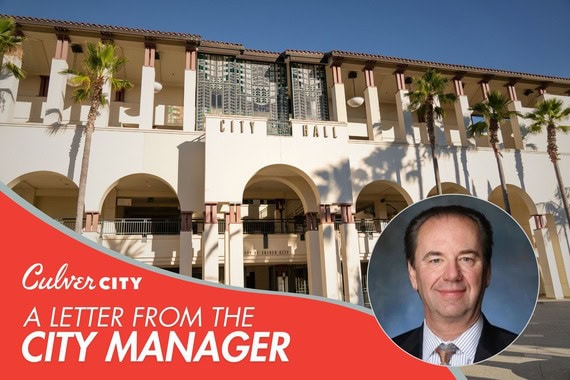
Dear Friends and Neighbors,
As I prepare to conclude my 15-year tenure as your City Manager and my 46-year career in city management, I want to share a few reflections on what I have learned and what I believe is essential to Culver City’s continued health, safety, and spirit.
Cities are Systems – A city is a living system of services creating opportunity, safety, and belonging. When all parts of the system are healthy and connected, a city thrives.
Public safety services, including police, fire, emergency medical, and mental health crisis response, rapidly provide compassionate care to people in need, ensuring people are safe to enjoy the rest of the city’s amenities. Public works services keep the city functional, resilient, and equitable by maintaining streets, sidewalks, sewers, storm drains, and public facilities. Transportation services provide mobility through buses, paratransit, bike and pedestrian networks, and traffic management. These connect people to work and school while reducing greenhouse gases and congestion. Parks and recreation services care for the shared spaces where we connect and play and which are the heart of a humane and inclusive community. Planning, housing, and economic development services shape our long-term vision, expand affordable housing, and foster sustainable growth. Administrative services such as finance, human resources, information technology, and legal services ensure transparency, accountability, and continuity.
A prosperous community relies on each part of the system, but public safety is the essential foundation upon which all other parts of the system are built.
Keeping a community safe means more than simply responding to emergencies. It means addressing the underlying crises that can lead to emergencies. That’s why mental health crisis response has become an essential component of public safety. Co-responder and alternative-response teams are expanding the traditional boundaries of emergency services, ensuring that individuals in crisis are met with empathy, clinical support, and the right level of care. A city can respond more humanely and effectively to the full spectrum of needs because these programs complement police and fire response.
Culver City’s efforts to address homelessness and housing insecurity reflect that public safety includes freedom from harm, access to help, housing, and hope. Public safety is what allows progress to take root and endure. Mental health crisis response teams rely on coordinated 911 systems and trained first responders to assist with their mission. Homeless outreach is more effective in safe public spaces and with reliable emergency support. Affordable housing thrives in communities when residents feel safe.
One of the great privileges of my career has been to witness how deeply people care about their parks, public spaces, and public and performing arts. Parks, recreation, and the arts are the connective tissue of community life. They foster health, climate resilience, and equity. They express our shared identity and creativity.
Likewise, maintaining our roads, bridges, utilities, and public facilities is an act of fairness and foresight. Deferred maintenance widens inequality and burdens future generations. Stewardship of our infrastructure is how we care for those who will inherit this City after we are gone.
An effective transportation system also reflects our commitment to equity. Every bus line, crosswalk, bike lane, and accessible curb ramp declares that everyone deserves safe, affordable, and sustainable ways to move through their city. Mobility ensures the right to participate in civic life.
City Budgets are Constrained – I am sometimes asked why the City can’t simply move money from one area to another to fund new priorities. The answer lies in the unceasing demand for fundamental municipal services. Most of the City’s existing spending supports ongoing essential operations, such as public works, public safety, utilities, human resources, payroll, and technology. These are 24-hour services with fixed costs, labor agreements, and legal mandates. After we pay for those obligations, the remaining portion of the General Fund is relatively small.
Compounding that challenge, cities have a limited ability to increase revenues. State law and national economic cycles beyond our control govern our primary revenue sources, which are sales tax, business tax, transient occupancy tax, and property tax. In Culver City, roughly 70 percent of General Fund revenues come from commercial activity. Spending at local businesses, hotels, restaurants, and retail centers generates the tax base that supports essential services. This means maintaining a healthy local economy is not a peripheral issue. The local economy funds everything from police response to park maintenance and arts programming. Public safety is essential for economic vitality; economic vitality is essential for community well-being.
Because our ability to raise new revenue is constrained, each new service we add must be implemented carefully as part of a sustainable long-term financial plan. The most resilient cities grow their commitments in balance with their economic capacity, ensuring that today’s progress can be maintained tomorrow.
The Demand for City Services is Growing – During the final years of my tenure, I’ve reflected on how our local government must evolve to support our changing community. Our population has remained stable for decades, but the number of 911 calls to our Police and Fire Departments has grown sharply in recent years. Our public safety personnel are responding to complicated emergencies that reflect nationwide systemic problems.
At the same time, Culver City is about to experience its first meaningful population growth in decades. Culver City has recently approved more than 4,400 new housing units, which will add an estimated 6,600 new residents during the next few years. The growth will improve housing access and economic vitality but will also increase the demand for city services. Meeting the increased demand for city services will require careful financial planning by city leaders. Culver City’s challenge will be to manage resources across all city services with flexibility and discipline. We must invest in safety, care, culture, and infrastructure while continuing to modernize service delivery.
Culver City needs an effective, collaborative, and fiscally sustainable public safety system that enables us to deliver essential city services as our community grows and changes. Cities are healthiest when they balance compassion with financial competence. Leading with empathy while maintaining fiscal discipline defines a model progressive city.
Trust is the Currency of Local Government – Public service has been my life’s work. What I have learned most deeply is that trust is the currency of local government. A city builds trust over time by reliably providing safety and fairness. In order to keep Culver City a place where everyone feels safe and included we must continue to invest in people, parks, the arts, infrastructure, housing, transportation, and a compassionate public safety model that includes mental health response. Prudently managing our resources and protecting the local economy that sustains them will ensure Culver City remains a vibrant and welcoming community.
Thank you for the honor of serving you. It has been the privilege of my career.
With gratitude and respect,

John Nachbar
City Manager from 2010-2025


